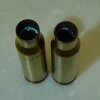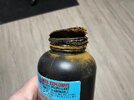You are using an out of date browser. It may not display this or other websites correctly.
You should upgrade or use an alternative browser.
You should upgrade or use an alternative browser.
Powder preservation
- Thread starter Akula69
- Start date
Mindset of most people that reload is an aversion to anyone else's reloads. "Only two people I trust to get this right are you and me.......and I'm not so sure about you".
I have concluded best plan is to load as you go. Powder, primers and bullets in original containers are seen as assets. Same components in loaded form generally seen as a liability.
Another example, I loaded 100 or so rounds for a rifle I now know is in desperate need of a new barrel. What I loaded for existing barrel almost certainly won't work for the new barrel. Get to pull it all down and start over. Imagine if I had 1,000 rounds like that.
I have concluded best plan is to load as you go. Powder, primers and bullets in original containers are seen as assets. Same components in loaded form generally seen as a liability.
Another example, I loaded 100 or so rounds for a rifle I now know is in desperate need of a new barrel. What I loaded for existing barrel almost certainly won't work for the new barrel. Get to pull it all down and start over. Imagine if I had 1,000 rounds like that.
I did not create that label, the old Gun Club President did when he loaded that ammunition. He purchased WW2 era production "IMR 4831" in the early 1950's and gave me a tin about 10 years ago. His powder probably came in drums like this:So, maybe I'm interpreting wrong....
One pic shows "IMR4831", and others say "WWII"...
Does that mean one is commercial IMR 4831, and the others are powder left from old powders left or scavanged from old military stores?

I copied this picture long ago, forget where. The poster was bragging about his stash of powder. Which he keeps in the house. Have to wonder, just when will it autocombust?
President was in a group buy of 4831. One buyer used his to light charcoal briquets, surplus powder was cheaper than lighter fluid! After receiving a Dupont tin filled with that "IMR 4831" powder from the Pres, I shot it in 270 Win over the chronograph. I did not experience any funnies even though the inside of the tin was rusty. I stored it in the shed, so if it did autocombust, I would not die in flames in my bed. I just poured that tin out last month, and you know what, no smell! Lots of red in the air, because it was stored in a 1970's tin, which rusted inside from NOx outgassing from the powder. I still did not trust it especially for what it did to the Gun Club president's ammo. Got tired of waiting for it to fume. Maybe it would go past the fume stage right to autocombust.
The Pres used an old Dupont can, same vintage of can as these Dupont cans:

Would anyone want to reload that stuff?
Every round of 300 Win Mag that the Pres loaded with "IMR 4831" was loaded with that WW2 stuff and every case had internal corrosion and the cases were ruined.
Tins rusted, and rust is ionic, and ionic materials deteriorate gunpowder. That is probably why gunpowder comes in black plastic bottles. Which plastic they use, I have no idea. If powder hoppers are a clue, gunpowder will attack some plastics.

Blue68f100
Member
I've tore down factory ammo that had NO indication of deterioration on the outside. Once I pulled the bullet you could see the deterioration and corrosion. This was some old 8mm ammo from the 70's.
https://www.thehighroad.org/index.php?threads/powder-breaking-down.893636/
https://www.thehighroad.org/index.php?threads/powder-breaking-down.893636/
Jim Watson
Member
Black HDPE. I figure the black color is carbon black for opacity and anti-static.Which plastic they use, I have no idea. If powder hoppers are a clue, gunpowder will attack some plastics.
My Dillon and MEC powder hoppers are stained after long use. Powder left in a Redding was well on its way to rotting clear through their plastic in pretty short order.
Old Star and Phelps loaders had tempered glass and metal hoppers, hint, hint.
Hey, if you worry about powder shelf life, shoot black. No funky organic compounds to rot.
Lasting forever is what we want, but that's not what we are going to get.But those reactions aren’t exactly what we want from our smokeless reloading powders, and the entire thought experiment is really much ado about nothing, since we know storing powders in cool, dry storage away from sunlight can, will, and does sustain powder longer than any of us will live.
No one remembers these powder recalls, but reading the recall, it becomes obvious that these recent made powders deteriorated so rapidly, I bet a number of houses burnt down, hence, the recall.



Break the seals and sniff the stuff. I don't own a $250,000 gas chromatograph which would tell me how much stabilizer is left, and I don't own a pressure barrel which would tell me if the pressure curve has shifted, or is unstable. All I can do is use the five senses I have, which are very, very, poor in determining gunpowder lifetime and stability. But if I smell something, I pour it out:

You can see in this chart, the presenter is showing one lot of aged propellant, and how the pressure has increased with accelerated aging. I don't know what the stability requirement is, but he is testing for it.

Captain*kirk
Member
Your solution is simple, and right in front of you.
Load what ya got and buy new powder. Then shoot off what you loaded.
Your powder is always fresh.
Load what ya got and buy new powder. Then shoot off what you loaded.
Your powder is always fresh.
jmorris
Member
- Joined
- Sep 30, 2005
- Messages
- 24,324
I have seen both, unfortunately. Original container is definitely best though.
View attachment 1207418View attachment 1207419
Where was that bottom one stored?
EMC45
Member
- Joined
- Jul 20, 2008
- Messages
- 1,957
I have old rail car H4895 in the cardboard cans from the 60s. Shoots fine.
I got this powder from a buddy who’s neighbor died and my buddy was put in charge of cleaning his house out. I got a large quantity of powder and it was all stored in the guys hot garage (in GA) in an old wooden ammo box. Some was even in old paper bags. I’ve shot a lot of it and it all did perfectly fine. I’m still shooting it too!
I got this powder from a buddy who’s neighbor died and my buddy was put in charge of cleaning his house out. I got a large quantity of powder and it was all stored in the guys hot garage (in GA) in an old wooden ammo box. Some was even in old paper bags. I’ve shot a lot of it and it all did perfectly fine. I’m still shooting it too!
Akula69
Member
Some great information here - thanks to all.
The consensus is to remain in original containers...so that's what I'll do.
The consensus is to remain in original containers...so that's what I'll do.
Rimfire McNutjob
Member
To expand on prior notes, Argon is inert and in the noble gas column obviously. It's also readily available at welding gas suppliers. It's primarily used by TIG welders.
I have old rail car H4895 in the cardboard cans from the 60s. Shoots fine.
I got this powder from a buddy who’s neighbor died and my buddy was put in charge of cleaning his house out. I got a large quantity of powder and it was all stored in the guys hot garage (in GA) in an old wooden ammo box. Some was even in old paper bags. I’ve shot a lot of it and it all did perfectly fine. I’m still shooting it too!
Bud of mine has a 50 cal ammo can full of 45ACP ammunition he squirreled away before the Vietnam War. I was leery of the stuff, and he gave me five rounds to shoot.
I disassembled two, this is one



Everything looked good. I reassembled the two rounds, fired all five at the range. Each round went bang, cycled the mechanism, and hit planet earth. I offered bud a real low ball offer, because this stuff is 62 years old, and it ain't getting younger!
Bud refused, I am sure he sold it for more than I would give for it.
These are two charts from a 1969 and 1970 Insensitive Munitions Symposium.


They were dumping cartridges filled with IMR 4895 that were 28 years old, because it was no longer safe to store.
This is worth reading for an idea of how Museums deal with artifacts, such as film stock, and objects, made of nitrocellulose.
The Use of Cellulose Nitrate in Art Conservation
Dr. Charles Selwitz Getty Museum
P.S. They don't trust the stuff!
Similar threads
- Replies
- 14
- Views
- 3K



